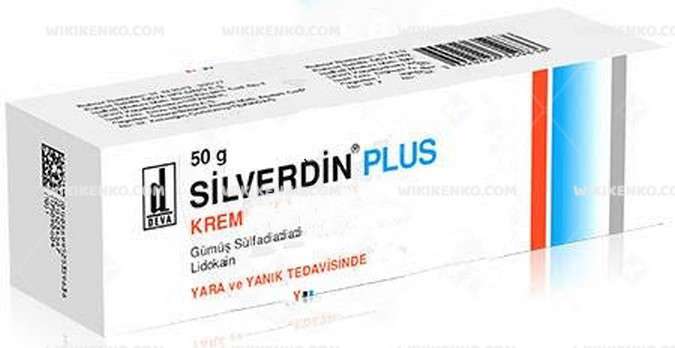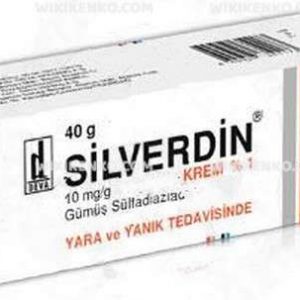Silverdin Plus Cream
Silverdin Plus Cream is a potent medicinal product containing two active substances, namely Silver sulfadiazine and Lidocaine, that work together to provide effective prophylaxis and treatment of burn wounds infected with Gram-positive and Gram-negative microorganisms susceptible to silver sulfadiazine. This cream is a water-miscible, soft-textured, and odorless white cream that has been clinically proven to prevent and treat infections in leg ulcers, pressure sores, skin graft donor sites, and extensive abrasions.
| Dosage form | |
|---|---|
| Pack size | |
| Potency | 50G |
| Manufacturer | |
| Origin | |
| Generic Name (Ingredient) | Silver Sulfadiazine 10.0 Mg Lidocaine 50.0 Mg |
Assuming your emergency circumstances for this product, visit Urgent Quotation page. Besides, for any pharmaceutical questions, please ask us in the comments section.
Description
Indications
The Silverdin Plus Cream is an excellent adjunct to short-term treatment of infection in leg ulcers and pressure sores, as well as prophylaxis of infection in skin graft donor sites and extensive abrasions. The product is also suitable for the conservative management of finger-tip injuries where pulp, nail loss, and/or partial loss of distal phalanx has occurred. It is designed to provide immediate and long-lasting relief for patients who require prompt attention for burn wounds and other types of injuries that require antibiotic treatment.
Administration
Silverdin Plus Cream is intended for topical application only and should not be administered ocularly. To avoid exceeding the maximum dose of Lidocaine, the dose applied at a time should not be more than 250 mg, which is equivalent to 5 g of the cream. Moreover, the daily dose of 17-20 g of Silverdin Plus Cream (equivalent to 850-1000 mg of Lidocaine) should not be exceeded.
For burns, the cream should be applied as a layer with 3-5 mm thickness after the wound and burned area are cleaned in line with hygiene rules. This application is best achieved with a sterile gloved hand and/or sterile spatula. The cream should be reapplied to any area from which it has been removed by patient activity. For leg ulcers/pressure sores, the cavity of the ulcer should be filled with Silverdin Plus Cream to a depth of at least 3-5 mm. Cleansing and debriding should be performed before application of the cream. It is recommended to follow up the application with an absorbent pad or gauze dressing and appropriate pressure bandaging.
Precautions
While Silverdin Plus Cream is generally safe and effective, very frequent application on a large surface may cause hypersensitivity, and therefore, such kind of application is not recommended. It is also important to avoid spreading the cream onto non-ulcerated areas to prevent maceration of normal skin on prolonged contact.
Side Effects
Like all medicines, Silverdin Plus Cream may cause side effects, although not everyone experiences them. The most common side effects of the cream include itching, irritation, and a burning sensation at the site of application. However, rare side effects may include skin flaking or discoloration, eczema, rash, warming or irritation in the applied area, nausea and vomiting, skin necrosis (formation of fluid-filled blisters on the skin), loss of appetite, and difficulty in breathing. If you experience any of these side effects while using Silverdin Plus Cream, it is important to consult with your doctor immediately.
Conclusion
Silverdin Plus Cream is a potent medicinal product that contains two active substances, Silver sulfadiazine and Lidocaine, which provide prophylaxis and treatment of burn wounds infected with Gram-positive and Gram-negative microorganisms susceptible to silver sulfadiazine. It is a water-miscible, soft-textured, and odorless white cream that is easy to apply and can be used for a variety of skin injuries. It is important to follow the recommended dosage
Use the form below to report an error
Please answer the questions as thoroughly and accurately as possible. Your answers will help us better understand what kind of mistakes happen, why and where they happen, and in the end the purpose is to build a better archive to guide researchers and professionals around the world.
The information on this page is not intended to be a substitute for professional medical advice, diagnosis, or treatment. always seek the advice for your physician or another qualified health provider with any questions you may have regarding a medical condition. Always remember to
- Ask your own doctor for medical advice.
- Names, brands, and dosage may differ between countries.
- When not feeling well, or experiencing side effects always contact your own doctor.
Cyberchondria
The truth is that when we’re sick, or worried about getting sick, the internet won’t help.
According to Wikipedia, cyberchondria is a mental disorder consisting in the desire to independently make a diagnosis based on the symptoms of diseases described on Internet sites.
Why you can't look for symptoms on the Internet
If diagnoses could be made simply from a textbook or an article on a website, we would all be doctors and treat ourselves. Nothing can replace the experience and knowledge of specially trained people. As in any field, in medicine there are unscrupulous specialists, differences of opinion, inaccurate diagnoses and incorrect test results.




Reviews
There are no reviews yet.